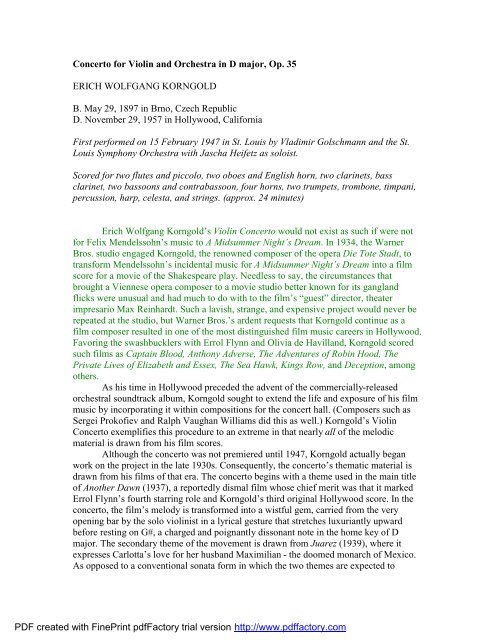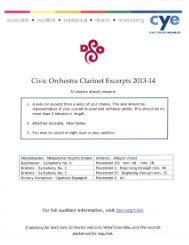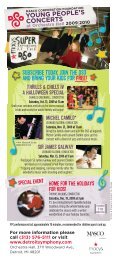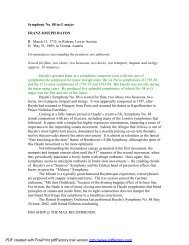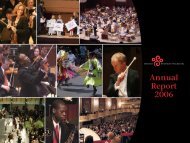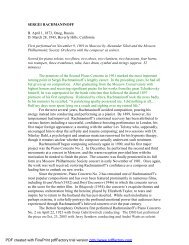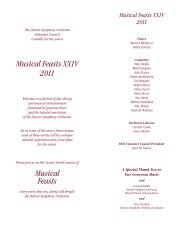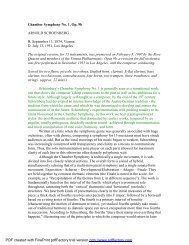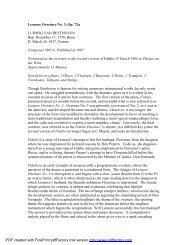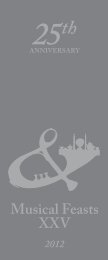Concerto for Violin and Orchestra in D major, Op. 35 ERICH ...
Concerto for Violin and Orchestra in D major, Op. 35 ERICH ...
Concerto for Violin and Orchestra in D major, Op. 35 ERICH ...
You also want an ePaper? Increase the reach of your titles
YUMPU automatically turns print PDFs into web optimized ePapers that Google loves.
<strong>Concerto</strong> <strong>for</strong> <strong>Viol<strong>in</strong></strong> <strong>and</strong> <strong>Orchestra</strong> <strong>in</strong> D <strong>major</strong>, <strong>Op</strong>. <strong>35</strong><br />
<strong>ERICH</strong> WOLFGANG KORNGOLD<br />
B. May 29, 1897 <strong>in</strong> Brno, Czech Republic<br />
D. November 29, 1957 <strong>in</strong> Hollywood, Cali<strong>for</strong>nia<br />
First per<strong>for</strong>med on 15 February 1947 <strong>in</strong> St. Louis by Vladimir Golschmann <strong>and</strong> the St.<br />
Louis Symphony <strong>Orchestra</strong> with Jascha Heifetz as soloist.<br />
Scored <strong>for</strong> two flutes <strong>and</strong> piccolo, two oboes <strong>and</strong> English horn, two clar<strong>in</strong>ets, bass<br />
clar<strong>in</strong>et, two bassoons <strong>and</strong> contrabassoon, four horns, two trumpets, trombone, timpani,<br />
percussion, harp, celesta, <strong>and</strong> str<strong>in</strong>gs. (approx. 24 m<strong>in</strong>utes)<br />
Erich Wolfgang Korngold’s <strong>Viol<strong>in</strong></strong> <strong>Concerto</strong> would not exist as such if were not<br />
<strong>for</strong> Felix Mendelssohn’s music to A Midsummer Night’s Dream. In 1934, the Warner<br />
Bros. studio engaged Korngold, the renowned composer of the opera Die Tote Stadt, to<br />
trans<strong>for</strong>m Mendelssohn’s <strong>in</strong>cidental music <strong>for</strong> A Midsummer Night’s Dream <strong>in</strong>to a film<br />
score <strong>for</strong> a movie of the Shakespeare play. Needless to say, the circumstances that<br />
brought a Viennese opera composer to a movie studio better known <strong>for</strong> its gangl<strong>and</strong><br />
flicks were unusual <strong>and</strong> had much to do with to the film’s “guest” director, theater<br />
impresario Max Re<strong>in</strong>hardt. Such a lavish, strange, <strong>and</strong> expensive project would never be<br />
repeated at the studio, but Warner Bros.’s ardent requests that Korngold cont<strong>in</strong>ue as a<br />
film composer resulted <strong>in</strong> one of the most dist<strong>in</strong>guished film music careers <strong>in</strong> Hollywood.<br />
Favor<strong>in</strong>g the swashbucklers with Errol Flynn <strong>and</strong> Olivia de Havill<strong>and</strong>, Korngold scored<br />
such films as Capta<strong>in</strong> Blood, Anthony Adverse, The Adventures of Rob<strong>in</strong> Hood, The<br />
Private Lives of Elizabeth <strong>and</strong> Essex, The Sea Hawk, K<strong>in</strong>gs Row, <strong>and</strong> Deception, among<br />
others.<br />
As his time <strong>in</strong> Hollywood preceded the advent of the commercially-released<br />
orchestral soundtrack album, Korngold sought to extend the life <strong>and</strong> exposure of his film<br />
music by <strong>in</strong>corporat<strong>in</strong>g it with<strong>in</strong> compositions <strong>for</strong> the concert hall. (Composers such as<br />
Sergei Prokofiev <strong>and</strong> Ralph Vaughan Williams did this as well.) Korngold’s <strong>Viol<strong>in</strong></strong><br />
<strong>Concerto</strong> exemplifies this procedure to an extreme <strong>in</strong> that nearly all of the melodic<br />
material is drawn from his film scores.<br />
Although the concerto was not premiered until 1947, Korngold actually began<br />
work on the project <strong>in</strong> the late 1930s. Consequently, the concerto’s thematic material is<br />
drawn from his films of that era. The concerto beg<strong>in</strong>s with a theme used <strong>in</strong> the ma<strong>in</strong> title<br />
of Another Dawn (1937), a reportedly dismal film whose chief merit was that it marked<br />
Errol Flynn’s fourth starr<strong>in</strong>g role <strong>and</strong> Korngold’s third orig<strong>in</strong>al Hollywood score. In the<br />
concerto, the film’s melody is trans<strong>for</strong>med <strong>in</strong>to a wistful gem, carried from the very<br />
open<strong>in</strong>g bar by the solo viol<strong>in</strong>ist <strong>in</strong> a lyrical gesture that stretches luxuriantly upward<br />
be<strong>for</strong>e rest<strong>in</strong>g on G#, a charged <strong>and</strong> poignantly dissonant note <strong>in</strong> the home key of D<br />
<strong>major</strong>. The secondary theme of the movement is drawn from Juarez (1939), where it<br />
expresses Carlotta’s love <strong>for</strong> her husb<strong>and</strong> Maximilian - the doomed monarch of Mexico.<br />
As opposed to a conventional sonata <strong>for</strong>m <strong>in</strong> which the two themes are expected to<br />
PDF created with F<strong>in</strong>ePr<strong>in</strong>t pdfFactory trial version http://www.pdffactory.com
contrast <strong>in</strong> style <strong>and</strong> tone, Korngold’s freer <strong>for</strong>m (which eschews the typical development<br />
section <strong>in</strong> favor of a cadenza) emphasizes the two themes’ similarities - their lyrical,<br />
bittersweet character, expressed through gentle dissonances, expansively supple phrases,<br />
<strong>and</strong> the viol<strong>in</strong>’s delicate <strong>and</strong> brilliant upper register.<br />
The second movement is based on themes from Anthony Adverse (1936), the film<br />
score <strong>for</strong> which Korngold received his first Academy Award. Interest<strong>in</strong>gly, the treatment<br />
of the film’s central love theme is radically reconceived <strong>in</strong> the concerto. Its square<br />
rhythms <strong>and</strong> solid harmonic foundation are replaced by a free, me<strong>and</strong>er<strong>in</strong>g fantasy<br />
through which the viol<strong>in</strong>ist drifts on arabesques, leav<strong>in</strong>g beh<strong>in</strong>d any sense of metered<br />
pulse. Although an excerpt of the theme’s orig<strong>in</strong>al <strong>for</strong>m appears towards the end of the<br />
movement, even this is buried <strong>in</strong> the orchestral accompaniment, an all-but-<strong>for</strong>gotten seed<br />
from which the second movement spr<strong>in</strong>gs.<br />
The f<strong>in</strong>ale is an ebullient frolic based loosely on the theme <strong>and</strong> variations <strong>for</strong>m.<br />
The ma<strong>in</strong> thematic material is drawn from The Pr<strong>in</strong>ce <strong>and</strong> the Pauper (1937) <strong>and</strong><br />
preserves the spirit of this light-hearted film about two boys who switch places to learn<br />
how the other half lives. In contrast to the pervasive lyricism of the first two movements,<br />
the f<strong>in</strong>ale is a mad-dash scramble as orchestra <strong>and</strong> soloist trade virtuosic passages. The<br />
movement rarely takes itself seriously: <strong>in</strong> the f<strong>in</strong>al measures the orchestra gr<strong>in</strong>ds to a halt<br />
on a grat<strong>in</strong>g, m<strong>in</strong>or second dissonance be<strong>for</strong>e f<strong>in</strong>ish<strong>in</strong>g with a resound<strong>in</strong>g, “all’s well” D<br />
<strong>major</strong> hit.<br />
The Detroit Symphony <strong>Orchestra</strong> last per<strong>for</strong>med Korngold’s <strong>Concerto</strong> <strong>for</strong> <strong>Viol<strong>in</strong></strong><br />
<strong>and</strong> <strong>Orchestra</strong> <strong>in</strong> D <strong>major</strong> on July 10, 1988 with John Nelson conduct<strong>in</strong>g <strong>and</strong> Ida Haendel<br />
as soloist.<br />
DSO Shop @ The Max Recommends:<br />
Korngold, <strong>Viol<strong>in</strong></strong> <strong>Concerto</strong>, Anne-Sophie Mutter, viol<strong>in</strong>, André Prev<strong>in</strong> conduct<strong>in</strong>g the<br />
London Symphony <strong>Orchestra</strong>, Deutsche Grammophon B000<strong>35</strong>26.<br />
Program note by Nathan Platte, doctoral c<strong>and</strong>idate <strong>in</strong> musicology with a focus on film<br />
music at the University of Michigan.<br />
PDF created with F<strong>in</strong>ePr<strong>in</strong>t pdfFactory trial version http://www.pdffactory.com


